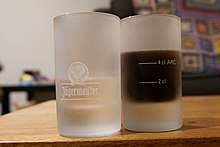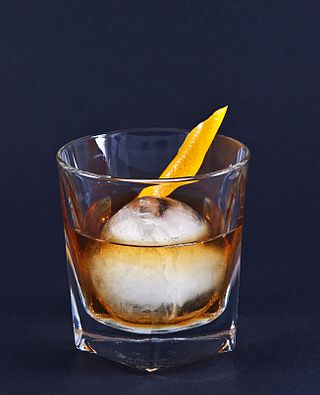
The old fashioned is a cocktail made by muddling sugar with bitters and water, adding whiskey or sometimes brandy, and garnishing with an orange slice or zest and a cocktail cherry. It is traditionally served with ice in an old fashioned glass.

In recipes, quantities of ingredients may be specified by mass, by volume, or by count.
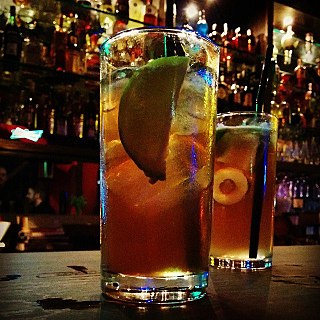
The Long Island iced tea, or Long Island ice tea, is an IBA official cocktail, typically made with vodka, tequila, light rum, triple sec, gin, and a splash of cola. Despite its name, the cocktail does not typically contain iced tea, but is named for having the same amber hue as iced tea.

The daiquiri is a cocktail whose main ingredients are rum, citrus juice, and sugar or other sweetener.
The dram is a unit of mass in the avoirdupois system, and both a unit of mass and a unit of volume in the apothecaries' system. It was originally both a coin and a weight in ancient Greece. The unit of volume is more correctly called a fluid dram, fluid drachm, fluidram or fluidrachm.

A standard drink or unit of alcohol is a measure of alcohol consumption representing a fixed amount of pure alcohol. The notion is used in relation to recommendations about alcohol consumption and its relative risks to health. It helps to educate alcohol users. A hypothetical alcoholic beverage sized to one standard drink varies in volume depending on the alcohol concentration of the beverage, but it always contains the same amount of alcohol and therefore produces the same amount of drunkenness. Many government health guidelines specify low to high risk amounts in units of grams of pure alcohol per day, week, or single occasion. These government guidelines often illustrate these amounts as standard drinks of various beverages, with their serving sizes indicated. Although used for the same purpose, the definition of a standard drink varies from country to country.

A pint glass is a form of drinkware made to hold either a British imperial pint of 20 imperial fluid ounces (568 ml) or an American pint of 16 US fluid ounces (473 ml). Other definitions also exist, see below. These glasses are typically used to serve beer, and also often for cider.
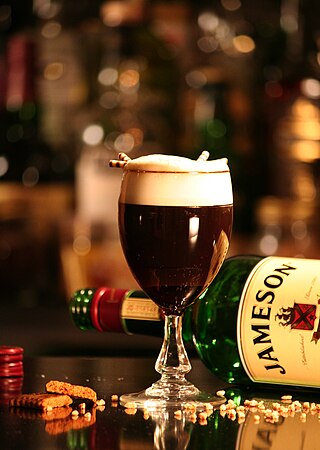
A liqueur coffee is a caffeinated alcoholic drink that consists of a shot of liqueur, mixed with coffee. It is typically served in a liqueur glass, often accompanied with cream and sugar. Coffee liqueur beverages are served in different fashions and can be found throughout many countries. One of the most popular liqueur coffee beverage is commonly known as Irish coffee. Liqueur coffee beverages are largely classified as cocktails as well as digestifs which are aimed at aiding the digestive process typically after a meal.

Various unique terminology is used in bartending.
Alcohol measurements are units of measurement for determining amounts of beverage alcohol.

The old fashioned glass, otherwise known as the rocks glass, whiskey glass, and lowball glass, is a short tumbler used for serving spirits, such as whisky, neat or with ice cubes. It is also normally used to serve certain cocktails, such as the old fashioned. The true old fashioned glass is decorated in the cut glass style, although most modern examples are pressed glass, made using a mold. The design is essentially English, from the late 18th or 19th century. Plain glass versions are lowball glasses.

A shooter, or shot, is a small serving of spirits or a mixed drink, typically consumed quickly, often in a single gulp. It is common to serve a shooter as a side to a larger drink.
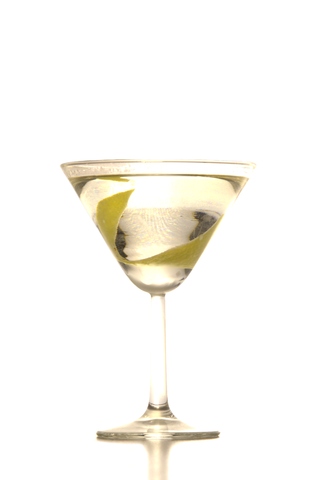
The Vesper is a cocktail that was originally made of gin, vodka, and Kina Lillet. Since that form of Lillet is no longer produced, modern bartenders need to modify the recipe to mimic the original taste, with Lillet Blanc or Cocchi Americano as a typical substitute.

The Fine Art of Mixing Drinks is a book about cocktails by David A. Embury, first published in 1948. The book is noteworthy for its witty, highly opinionated and conversational tone, as well as its categorization of cocktails into two main types: aromatic and sour; its categorization of ingredients into three categories: the base, modifying agents, and special flavorings and coloring agents; and its 1:2:8 ratio for sour type cocktails.

The Ward 8 or Ward Eight is a cocktail originating in 1898 in Boston, Massachusetts, at the bar of the Gilded Age restaurant Locke-Ober.

A Seven and Seven or 7 and 7 is a highball cocktail, a mixed alcoholic drink containing Seagram's Seven Crown, a blended whiskey, and 7 Up, a lemon-lime soft drink. It is typically served with ice. It was one of the most popular drinks in the United States during the 1970s.

An alcoholic beverage is a drink that contains ethanol, a type of alcohol and is produced by fermentation of grains, fruits, or other sources of sugar. The consumption of alcoholic drinks, often referred to as "drinking", plays an important social role in many cultures. Alcoholic drinks are typically divided into three classes—beers, wines, and spirits—and typically their alcohol content is between 3% and 50%.
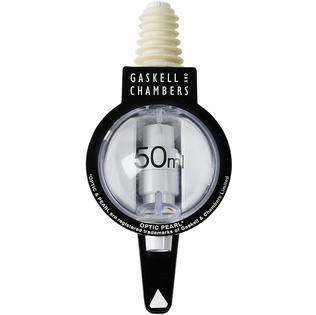
Alcoholic spirits measures are instruments designed to measure exact amounts or shots of alcoholic spirits.

A tumbler is a flat-floored beverage container usually made of plastic, glass or stainless steel.



